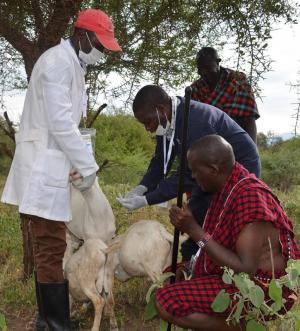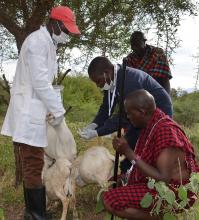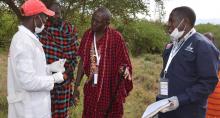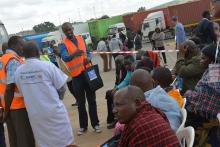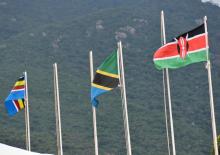Cross-border Field Simulation Exercise comes to a close
Namanga One Stop border Post, Kenya/Tanzania/18 June 2019 - Jackson Tipapa, a Kenyan cattle farmer, sat at his Loitokitok home with his family members and neighbours, and explained to a team of health and livestock experts about the dire situation on his farm.
The 48-year old husband and father of four represented a distraught community whose cattle were dying. A strange disease was threatening further loss of their goats, sheep and what was left of his cows.
“The cattle are weak and ill with diarrhoea. Some have died while others have miscarried,” he told the visiting team. And it was not just livestock that was affected. Some people in the community have fallen sick – with diarrhoea, high fever and vomiting.
Meanwhile, in Longido on the Tanzanian side, another farmer explained a similar situation to a visiting team of health experts and responders.
The experts are part of a Rapid Response Team that had received an emergency alert about the farmers’ deteriorating situation. They examined the animals and took dung and blood samples for further testing while health workers engaged members of the community and responded to their concerns.
Fortunately, the situation was just a simulation, and at the end of the exercise, all the ‘sick’ people were able to return to their families. Tipapa and his community were participants in a Field Simulation Exercise (FSX) which occurred 11-14 June at the Namanga One Stop Border Post and the surrounding areas in both Kenya and Tanzania. The exercise was convened by the East Africa Community (EAC) to test the two countries’ preparedness and response to outbreaks. It involved various real-life simulations, involving all related sectors including health, livestock, agriculture, tourism and environment.
In reality, the situation presented was not unusual and highlighted the daily challenge of managing the risk of diseases spreading.
“Our animals do regularly get infected by various diseases,” Tipapa said, explaining that people herding cattle criss-cross the borders.
“We are always looking for pasture for our cattle because it is our livelihood and for us the border is a non-issue. The cattle have to eat and the rains and availability of pasture determine what direction our cattle should go. We are happy to learn what to do if we or our animals get sick.”
Other scenarios mimicked common border situations and showed the danger of disregarding standard operating procedures and other guidelines that help guard against disease outbreaks that affect both humans and animals.
The rapid response teams acted on emergency alerts sent from a control room and follow-up response was tested to examine how efficiently health teams and other emergency teams were responding to emergencies.
“We planned it so that every possible element of the system is tested and so that we can examine how ready such a system is for any impending outbreak,” Frederik Cooper, WHO technical lead of the exercise said.
Such readiness is carried out in real life settings to determine the level of preparedness and response and to assess operational capabilities at regional and national levels. The exercises focused on strengths and weaknesses in coordination and collaboration mechanisms, emergency response deployment, logistics and administrative processes, risk and crisis communication (RCC) and emergency management and leadership.
The simulation exercise’s scope and complexity drew the attention and interest of other members of the EAC community – Burundi, Rwanda, Uganda and South Sudan and other neighbouring countries from the World Health Organization (WHO) Africa Region that acted as observers to the process.
WHO is the lead technical agency requested by the EAC Secretariat to develop the exercise, and to design and coordinate its implementation. WHO partnered with the German Government through the Deutsche Gesellschaft für Internationale Zusammenarbeit (GIZ) GmbH, for financial support. Other partners include the Food and Agricultural Organization (FAO), Africa Centres for Disease Control, USAID, World Organization for Animal Health, OIE, Defense Threat Reduction Agency, DTRA, and the Kenya Red Cross. The exercise also had high level government support.
“The findings from the FSX will be used to further enhance preparedness and response capacities in the EAC region and beyond,” said Christophe Bazivamo, EAC Deputy Secretary General. He noted that the effort by the EAC countries and partners was timely given the Ebola epidemic in in DRC, which shares a border with five member countries.
The simulation identified clear strengths, including functional multi-sectoral collaboration; the effective use of the one-health approach; rapid response to alerts and deployment by some rapid response teams; and functional use and activations of standard operating procedures and guidelines. timely communication and coordination of messages would enhance such practices. Areas for strengthening include reporting flows in emergency operation centres between the countries and the EAC, more effective communication mechanisms, and improving the efficiency of ambulances and staffing at points of entry.
Communications & Social Mobilisation
Tel: +254 722509403
Cell: +254 710 149489
Email: mwakishaj [at] who.int (mwakishaj[at]who[dot]int)
Email: kileon [at] who.int (kileon[at]who[dot]int)
Tel: +255 755 551 804



